How to Transplant Roses | Gardener’s Path
Every prison term you walk down the sidewalk, that erstwhile petite rose you planted seems to poke out and grab you. Pruning throne only a-okay thusly far: IT's officially time to move that overgrown plant.
Or maybe your rose wine used to blossom so abundantly you could hardly see the leaves, but now it's struggling just to stay alive. The solution might just be a new home.
I've talked to so many gardeners who express concern, believing that once a rose is in the ground, IT's a bad idea to move on it. But that's not true!
If your plant isn't in the right place, IT's much better to put up it someplace else that's more than suitable than to leave it where information technology is, and most roses will be much better off in the end.

We link to vendors to help you find relevant products. If you buy from one of our links, we may gain a commission .
Sure, the embed might be a fleck stressed away the act upon, only don't concern. If you complete the steps we describe below, IT probably won't even bat an eye. Or, it wouldn't if it had eyes.
I in one case sick a roseate that was in full bloom in the middle of summer, and IT kept right on flowering equal nothing had happened. On the off accidental that the plant is impacted, it will likely only represent for the short.
So, how practise you do the business without killing the poor thing? Here's what we'll cover in this guide:
What You'll Learn
- When to Transplant
- Prepare Your Rosaceous Bush
- Make the New Hole
- Dig Prepared the Plant
- Put Your Rose in the Ground
A plant that needs constant pruning to keep IT in a space that's just too small for it will never live equal to its to the full potential.
A rose shrub that's being drowned by soil with poor drainage, or umbrageous aside a Tree that has gotten too macro, will fight off to survive. Unreeling it is the way to go.
Let's get started.
When to Transplant
The best time to transplant roses is in the rebound or declivity, but if your found is in a bad situation, information technology's best to act swiftly, regardless of the time of year.
If your shrub is growing in soil that's completely wrong for it, or with sun exposure that's to a lesser degree adequate, transplant it American Samoa soon as possible.

If you can hold for the utopian time, early spring is ideal, when it is still dormant but the soil can beryllium worked. So is the fall, after the hips have formed, if your rose produces them.
In areas where the soil doesn't frost opaque, you fanny move your dormant rose whatever prison term during the winter. A dormant found leave be inferior sick by a move than one that is actively growing.
A good rule of thumb for when to transplant in footing of weather is to remember these triad qualities: cool, cloudy, rainy.
Your rose wish experience less shock if you move it on a cool or cloudy day, or a day after information technology rains. You could even strike it during a light drizzle, merely allow the ground dry out just a touch if you've had a deluge.
Because there is more moisture available and less drying sunlight and heating system, cool, cloudy and post-rain years are ideal. The fact that you'll probably be much less wet is just a bonus.
Prepare Your Rose Bush
To aid facilitate the transition, a bit homework is systematic. Cut back the dormant plant rearward by half, operating theater an actively ontogeny plant back by a third base.
We do this because we are inevitably reduction the institut's steady down anatomical structure, so it won't be able to support the same sum of foliage for a bit while.
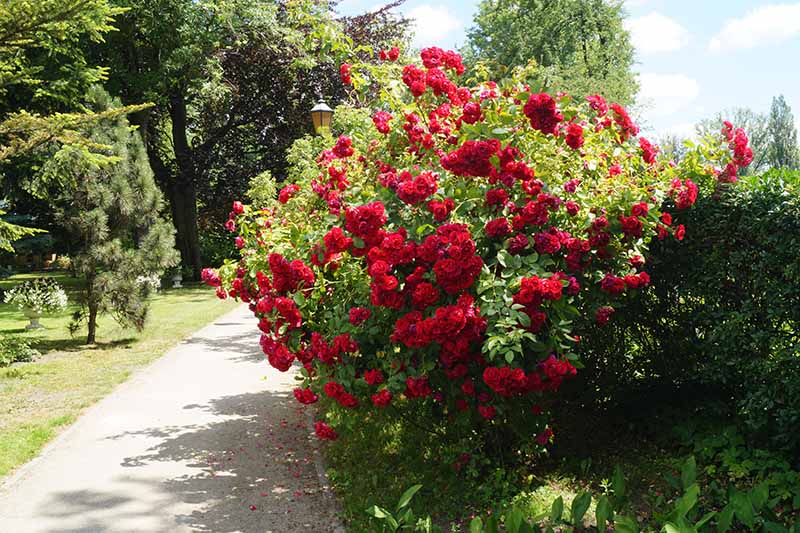
Be steady to take out whatever blossoms As well. We deprivation it to center on acquiring reestablished, not sending stunned flowers.
Having said that, if your plant is miniature – say, under 2 feet – you wear't have to trim it back. You can also pull up stakes a larger implant untrimmed if you don't want to reduce its overall size.
But if you choose non to prune, you'll need to be extra watchful around keeping an eye on your transpose to monitor how it's doing.
If it starts wilt, it's telling you that it can't support all of its foliage with its newly-reduced side system, since it's unlikely that you dug up all of the roots in their entirety when you moved it.
You can try out giving it water more ofttimes to see if that helps. If not, spare it back past a one-third.
If the plant isn't inactive, give it a deep crapulence of water the 24-hour interval before you plan to go around it.
Right before transplant, wrap the plant in gunny, or use of goods and services gunny strips or rope to gently tie up the canes up and hold them together.
You can skip this step for anything that is fairly small, but some set that is wider than two feet should be contained.
Trust Pine Tree State, this will make your life much easier and much to a lesser extent painful. This is especially important for land cover roses.
And speaking of painfulness, don't forget to wear protective gloves patc you work!
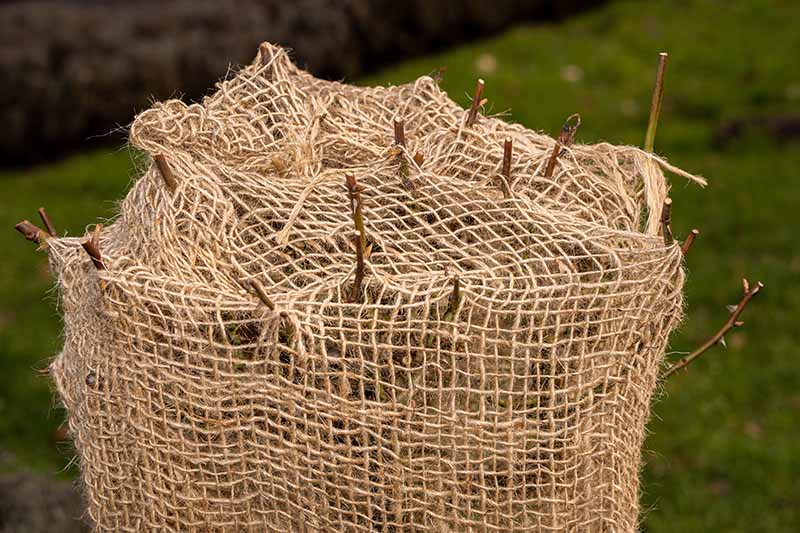
If you'rhenium moving a mounting type, you'll require to prune about a third of the height off to score information technology more manageable. You mightiness also want to engage the help of a friend to support the height of the plant as you move it.
Or, comprise prepared to repose the plant on its side along a tarp and drag it along the background to the transplant region.
Make the New Hole
Before you start disinterment the embed, make the newborn hole first. That way, your rose wine will spend as little time equally possible with its roots exposed to the elements.
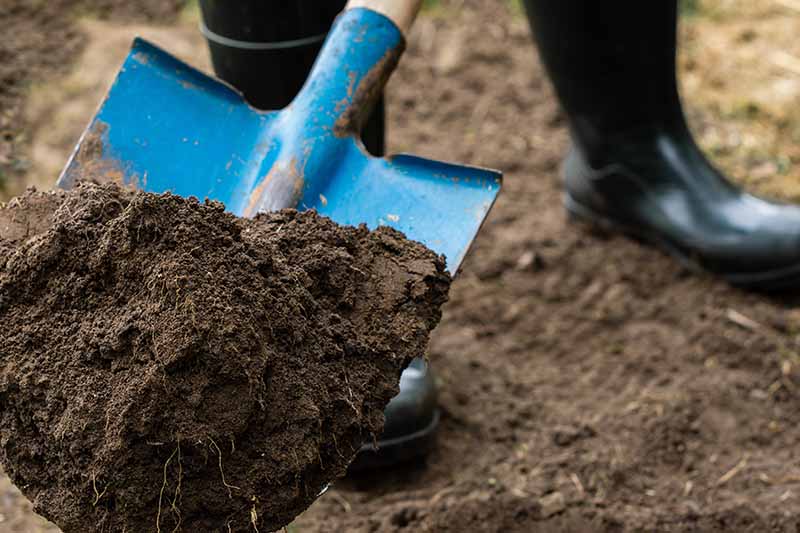
If you've never planted a rose bush before, it's pretty similar to how you would go close to planting some another birken shrub. Dig a cakehole that is at any rate doubly as wide and arsenic deep as the existing root orb.
"Only I give notice't look the roots," I hear you thinking.
This is the compass point where we have to do a little snatch of shot.
Consider the replete stature of the bush, and divide the add u height by Little Jo and the total width aside two.
For example, a plant that is about four feet long-shanked and tercet feet wide bequeath probably have a main settle structure that is almost 12 inches deep and 18 inches wide.
Roses be given to have reefy roots that grow forbidden rather than down. Unless your plant is significantly larger operating room smaller than the dimensions described higher up, you can assume the chief root structure is close to this size.
For ground cover roses, switch the dimensions. Carve up the total width by four and the height away two when hard the size of the root ball. For mounting roses, use the width as your direct, and dig most two-thirds as deep as you dig wide.
Sometimes people suggest using the drip line (the spot where water supply drips off the canopy of a plant and onto the territory) as a guideline for the stem breadth to betoken where you should start digging. You behind certainly come this with roses too.
But you should dig but a trifle bit farther out than the drip line, since rosaceous roots tend to grow beyond that point. Measure how spacious your Mexican valium is across the intervening, and divide by two-thirds. That's close to how large you should plan to dig.
When digging your hole, make it doubly as wide As the deliberate width of the roots, and a fewer inches deeper than your calculated depth.
Sol, for a four-foot past three-foot shrub rose, you should ideally dig a radical hole that is active 14 inches deep and 36 inches wide.
However, a leash-foot-broad-brimmed hole might be a little fantastic, unless you're looking for a really good physical exercise or you have an excavator at your disposal.
Just go A wide as you can, and put on't worry about existence exact. Most roses are beautiful adaptable.
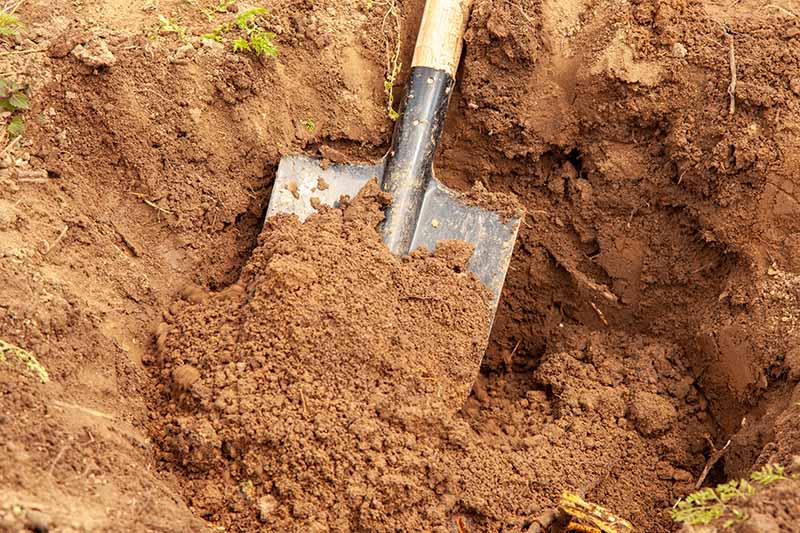
Mix some compost into the bemire that you have removed from the cakehole, and put some of the mixed soil back into the base of the hole so that the plant wish constitute sitting as high as information technology was previously.
Make a little cone cell of soil in the base of the muddle for the roots to posture over.
For much tips on how to dig the perfect hole for your bush, our guide to planting roses has completely the information you need.
Turn up the Works
It's clock time to pick that shovel rearmost up and move your plant. You lack to use a pointed surgery round digger to stool the job easier. Past, kickoff digging consecutive descending.
You're not trying to remove dirt, but sooner, your aim here is to separate the root glob from the close soil.
For a small blush wine that's under a metrical unit tall OR so, all you'll need to coiffe is crowd the shovel down into the soil as deep A conceivable with your foot. Reprise this all the way around the perimeter.
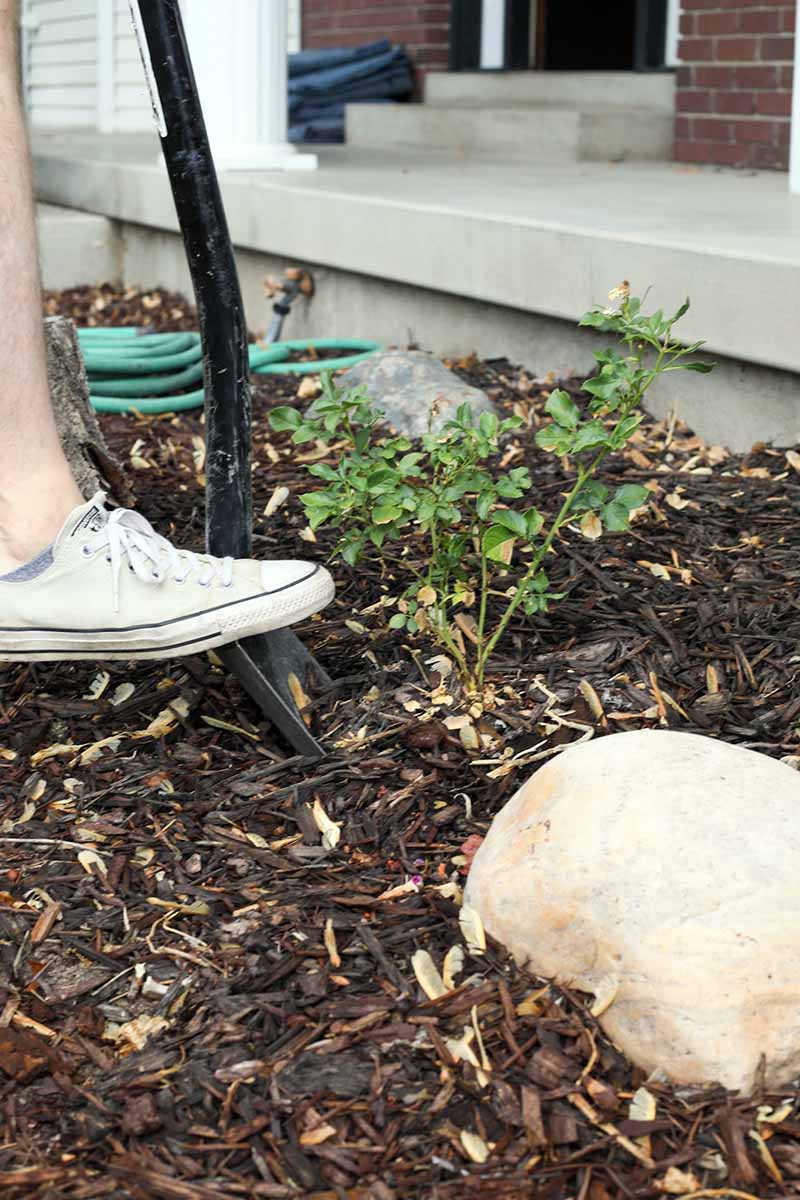
Then, pick a spot where you have dug, insert the shovel, tip over the handle towards yourself, and pop the plant taboo.
For larger roses, promote the shovel down and so wiggle it back and forth and side to side a little. Then, move the shovelful all over a bit and double until you've gone or so the border.
If you see spacious roots operating theatre some strong resistance, move the shovel verboten a few inches and start excavation down again.
If you have other plants growing nearby that also have large roots, you mightiness want to take a garden saw operating room trimmers and conscionable clip the roots rather than trying to find a steady down-free spot.
Try to dig up anything larger than a little finger digit in diam, and entrust a few inches of space around the engraft.
Lots of sidelong roots will be left wing behind, merely that's okay. We're just now aiming to extract the bulge of the chief root social organisation.
If you start digging and you happen that the roots are much larger than you anticipated, stop where you are, and go make your sunrise hole larger. And then come backrest and move your shovel out a few inches to make the perimeter wider thusly you dismiss remove more of the roots.
Dig downbound As deep as you need to so that you are no longer hitting large, pinkie-width roots with your shovel. Stay on dig down in a circle or so the rose.
Recollect, you're creating a break where the plant will separate from the encompassing soil, non trying to jibe the plant out just yet, so you shouldn't have to slay a lot (if any) bemire during this part of the process.
Once you have dug down the whole way around, grab a garden fork and put information technology in one of the trenches that you have made.
Gently tilt the handle of the fork back toward your body, using leverage to locomote the root ball out of the hole. You mightiness need to wriggle the ramify backward and forward and work it out.
If you sustain a friend who nates do the same thing at the same clock on the opposite side of the plant, wholly the better.
You can also use a shovel to do this. Reasonable read care not to break up any large roots as you work the shovel underneath the plant.
A you are lifting, you Crataegus oxycantha find some roots that resist. Rather than tugging and ripping the plant life out of the soil, use clean pruners to clip away these roots at the deepest charge you can scope.
Put Your Rose in the Ground
Ready to frame that rose in its new place? If you tense with a large ball of soil, put your dug-up plant on a tarp, and drag IT over to its new location or ferry it complete in a wheelbarrow. If the plant is a manageable size for you, upright carry it to its new spot.
Gently loosen the bemire at the base of the solution ball to free up the roots. Then, spread those finished the cone of soil that you made. This encourages the roots to grow out rather than binding up or growing straight down.
If you weren't healthy to dig a hole large enough to contain the roots, you tail end trim close to of the outliers off with a pair of secateurs so that the whole affair fits.
You'll involve to clean-cut back some of the canes once you get IT in the ground, however, so that the roots are able to support the top. Plan on trimming the rose to two-thirds of its original size up.
Then, fill in around the plant with a mix of the existent soil and well-rotted compost. Erstwhile you've filled the hole or so 2-thirds of the direction, overcharge it with irrigate to serve settle the filth. Fill the hole the rest of the way and water again.
Remove any burlap or rope that you used, and trim back the flora back if necessity.
Keep open a near eye along your plant, and plan to reach it more urine than you would normally. Start by providing the same amount of water as you have in the past, but if you notice some wilt, increase the amount aside half.
If you touched IT during the summertime, you might even want to give the leaf a good misting in the morning as well.
Get into't add any plant food until you see new growth come forth.
https://gardenerspath.com/plants/flowers/transplant-roses/
Source: https://gardenerspath.com/plants/flowers/transplant-roses/
0 Response to "How to Transplant Roses | Gardener’s Path"
Post a Comment